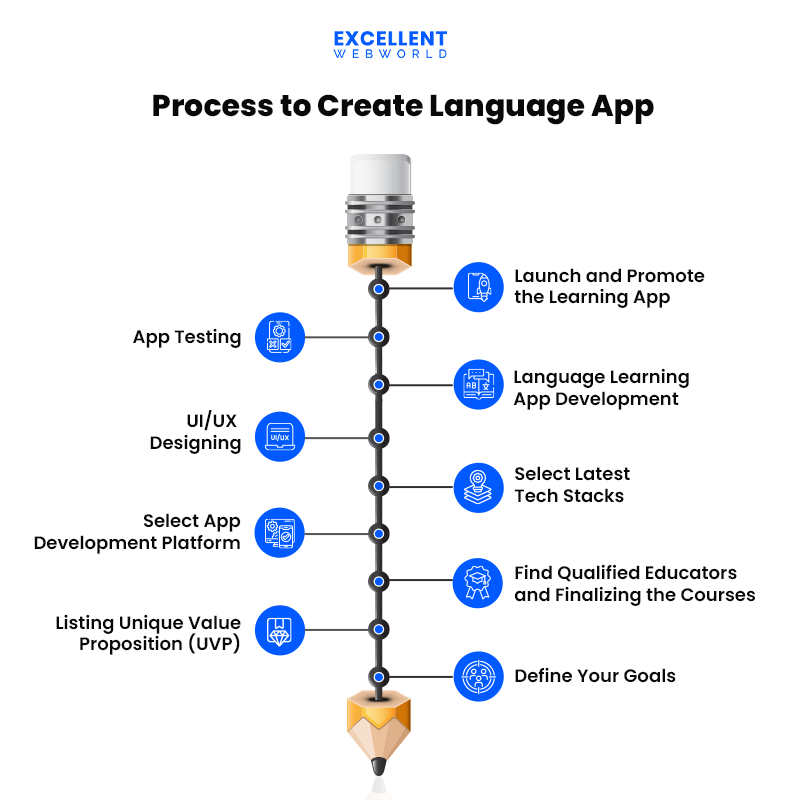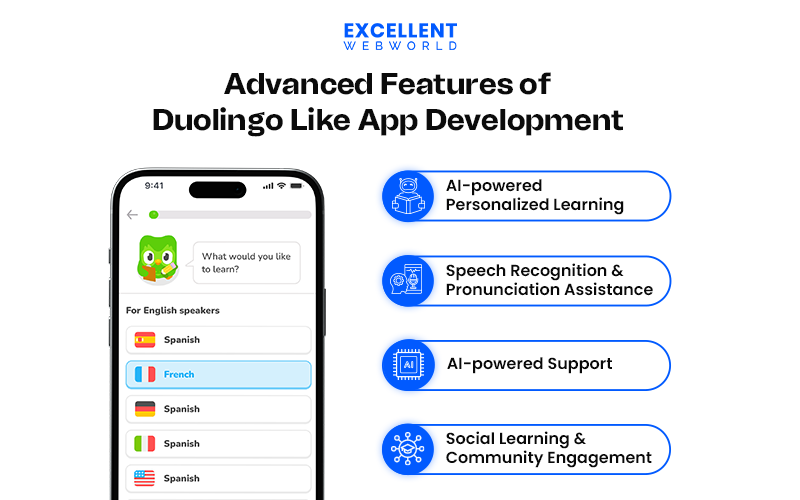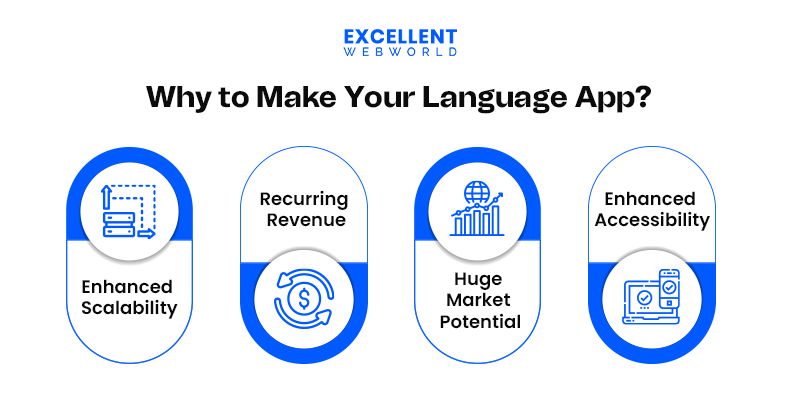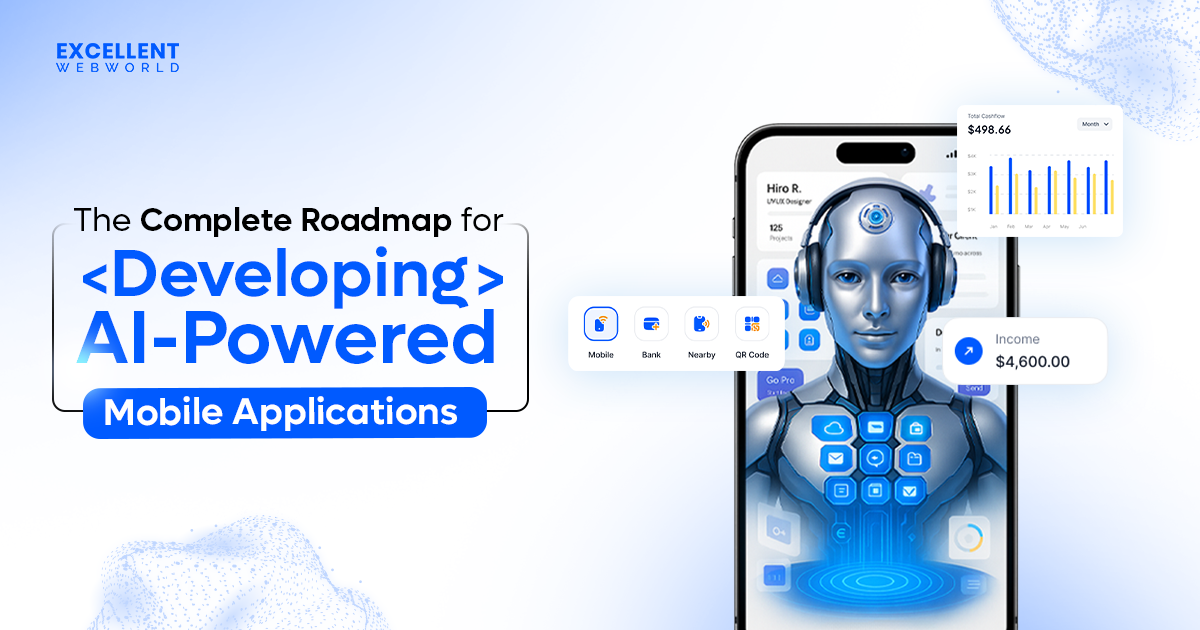Learning a new language has become super convenient with the introduction of Duolingo language learning app in the market. This has driven a craze in entrepreneurs, both established and aspiring ones for Duolingo like app development.
But why Duolingo, specifically?
Well, Duo’s fun “streak” feature that allows users to learn at their own pace and propels them to never skip via “cute, but threatening (in a funny way)” warning notifications has made it a pop culture phenomenon. With over 37.2 million daily active users (DAUs) (a 54% rise year over year) and its paid subscribers growing to 8.6 million (a 47% increase compared to the previous year), Duolingo is dominating the market—and how! No wonder why entrepreneurs are ready to invest in Duolingo like app development, more specifically.
Judging from the tremendous rate at which language learning apps like Duolingo are burgeoning, it makes sense that you want to create your own language learning app.
Let’s go through this step-by-step guide on how to make your own language app like Duolingo.
How To Make Your Own Language App like Duolingo?
Duolingo like app development needs strategic planning, extensive market research, and skilled collaboration. You’ll need to establish clear objectives, analyze language learning apps like Duolingo, and integrate engrossing features like gamification. The right platform and tech stack are paramount for a seamless user experience when aiming at a success similar to the Duolingo language learning app. You will learn about all these aspects in this section.
Step 1: Define Your Goals
Before initiating the design and development of a language learning app like Duolingo, it is essential to have a clear understanding of the educational app and its specifications. Analyzing the available learning platforms can simplify this process by finalizing the required features, flow, and UI/UX. On the other hand, determining the target audience helps streamline the foundational processes. Do your learners are students or corporates? Are they individuals who want to learn new skills or entrepreneurs seeking expert courses with certifications?
Key points to consider:
Step 2: Listing Unique Value Proposition (UVP)
Do you offer personalized courses for corporates when you make your own language app? Your specified UVP provides insights about distinctive learning solutions. It also helps users understand the value they will be getting from the app. Setting a unique value proposition is the secret ingredient to set your app apart from the market players. It is not just limited to this but aims to provide streamlined solutions to fulfil the learning needs of students, busy professionals, and other parties.
Key points to consider:
Step 3: Find Qualified Educators and Finalize the Courses
Defining UVP alone is not enough; finding experienced educators and deciding on courses are equally important. This process becomes more effortless in attracting learners based on comprehensive market analysis.
Key points to consider:
Step 4: Select App Development Platform
Most businesses face major issues choosing the ideal development platform, whether iOS, Android, or both. In this transformational market, however, selecting the right platform is essential for fulfilling the project requirements and providing an exceptional learning app. This helps deliver high-performing and feature-packed Duolingo-like app development services.
Key points to consider:
Step 5: Select Latest Tech Stacks
Traditional development tech stacks may lead to outdated online learning solutions, which hamper the overall user experience. Choosing advanced tech stacks and toolkits is the backbone of creating optimized language learning apps. This selection significantly impacts the user experience, responsiveness, security, and data management processes in the Duolingo app development process.
| Development Type | iOS App Development | Android App Development |
|---|---|---|
| Design |
|
|
| Programming Language |
|
|
| Toolkit |
|
|
| Dependency Management |
|
– |
| Database |
|
|
Key points to consider:
Step 6: UI/UX Designing
The designing phase is the combination of creativity and innovative thinking. It involves creating wireframes and interactive prototypes.
Are you aiming to use a gaming element in your design? Do you focus on creating engaging and fun learning experiences?
UI/UX design also involves using specific elements to create a gamified user experience. This includes implementing gamification throughout the app, including classrooms, online courses, and course selection. This mobile app design services helps boost student engagement and motivation.
There are several components required to be implemented while creating designs for mobile apps:
Information Architecture
Creating and structuring content and workflow that ensure smooth navigation and accessibility to diverse educational content in the app helps boost user engagement. Simplified dataflow and hierarchical learning information also help.
Wireframing
The Wireframe of the app involves creating a blueprint of the app, which assists in mapping out functionalities and app layout before starting the development process. This helps in checking the app flow and appearance before starting the development process.
Interactive and Engaging design
After creating the app concept and specifications, the next step involves defining and creating interactive designs. It includes creating custom icons, fonts, components, and full-proof designs to ensure a smooth user experience.
Defining Usability
A user-friendly design should help users easily access the required information. The usability of the language app should help users browse and access their required learning materials.
Visual Design
Creating and combining custom icons and colors is important for providing a smooth user experience. A visually appealing design helps create a unique and optimized app while maintaining usability.
Key points to consider:
Step 7: Language Learning App Development
Creating interactive and gamified app designs is now processed to give life. It involves using the finalized tech stacks and implementing the finalized wireframes and prototypes. Gamification is an aspect that boosts user experience but not at the cost of compromising learning.
Cross-platform learning software is also an ideal approach to boost accessibility and reach broader learners. To get full-proof learning apps, you can approach expert app development service providers to have gamified learning in your app. Developers integrate required features, functionalities, data security, and management approaches to provide streamlined progress.
The app development process can be divided into 2parts:
Backend Development
After the app design phase, the solution is processed for backend development, which includes creating a database, integrating APIs, and managing other components. A robust backend architecture helps respond to the requested query and manage the app flow smoothly.
Key points to consider:
Front end Development
Front-end app development usually involves designing and developing the components that users interact with and see. It also involves creating the user interface(UI) and user experience (UX) that help boost engagement.
Key points to consider:
Step 8: App Testing
Is your app bug-free? Does it provide smooth performance and a streamlined flow? Is every component responsive and enhances the user experience?
All these questions must be answered after creating a full-fledged educational app. Once the app is made, it is processed to test its performance, compatibility, and flow. If there are any bugs, they are resolved to provide a streamlined learning experience.
Key points to consider:
Step 9: Launch and Promote the Learning App
The official launch for public use and a predetermined marketing strategy roadmap is crucial to reach the user base. A successful launch also includes keeping the app up to date with the new course launch, technical advancements, onboarding new educators, and security measures. This ensures a streamlined workflow and boosts the user experience. Promotion of your educational app like Duolingo, can be done on various social media platforms to reach potential learners.
Key points to consider:
Essential Features to Implement in Language Learning Apps like Duolingo
Sign-in and Authentication
A smooth signup process is crucial for every mobile app. A priority should be keeping registration and profile setup processes simple, like Duolingo.
Manage Profile
You can manage and update your profile by updating your preferences, interests, and liked educators. Users can also save courses, lectures, and videos for future revisions.
Gamified Learning Experience
Make your own language app more engaging by providing gamified learning. Implementing gamification when you’re making something like Duolingo language learning app helps in keeping the users engaged. It simplifies the learning experience, and users can easily understand the specific content.
Wide Range of Courses
This feature allows users to search and browse for courses, ensuring a streamlined user experience. It also helps users enroll in the required classes that suit their interests and availability.
Multi-language Compatibility
Implementing diverse languages when you create your own language app allows users to choose their preferred language. This helps boost user engagement by setting the language level based on understanding. As a result, individuals from various age groups can smoothly utilize the app.
Online Tests and Revision
Users can easily check their progress and performance when implementing the revision and tests feature. It becomes an important feature when you are from a corporation when time is limited, and expertise is preferred. With this, learners can identify the improvement areas and work on them.
Certifications
Offering certification courses makes users more attractive and makes the solution more authentic. This can be done smoothly by collaborating with expert training institutes that provide certified courses. This move can be game-changing, proving that learning services are more reliable.
Interactive Lessons & Multimedia Content
Integrating visual and interactive learning sources helps make the learning experience more engaging and easily understood.
Progress Tracking & Analytics
Users can set daily and weekly goals for their course progress to stay updated on the status in real-time. They can also use performance analytics to earn enhanced improvement points.
Offline Mode & Downloadable Content
This feature is mainly accessible to the subscribed accounts to make learning more convenient and streamlined.
Push Notifications & Reminders
Providing real-time alerts and notifications helps users stay updated about new course launches, payments, class times, educators, and other relevant information.
Monetization & Subscription Models
Different monetization approaches are available to help apps like Duolingo language learning app generate revenue. These strategies include a freemium model, subscriptions, in-app purchases, advertisements, partnerships, and more. The app can implement monetization and subscription approaches based on the requirements and specifications.
In-app Payment
Users consider a secure and streamlined payment process ideal. Incorporating different payment options during the education app development process allows users to select their preferred payment mode.
Advanced Features To Include In Duolingo Like App Development
AI-powered Personalized Learning
Integrating advanced AI algorithms helps in providing customized learning experiences to users. The integration of AI offers recommendations based on user browsing and performance. Education app developers can also use AI algorithms to provide chatbots and smart assistants for seamless AI-powered learning and practice processes.
Speech Recognition & Pronunciation Assistance
With the implementation of advanced AI and ML technologies, users can improve their language communication and pronunciation using speech recognition features. They can also get quick feedback and conduct voice-based learning exercises to improve their conversational skills.
AI-powered Support
Chatbots allow users to get quick support and share their queries and concerns. This AI-enabled support provides quick solutions to shared difficulties. Implementing advanced technology in the education sector boosts the learning experience by ensuring user-friendly interfaces. It also supports multiple languages and skillsets, which can be configured easily based on preferences.
Social Learning & Community Engagement
Enroll in and join expert learning forums and communities to discuss specific subjects. This helps you solve peer-to-peer hurdles, learn what’s new in the field, and read tips, stories, reports, and exercises.
Why Make Your Own Language App?
1. Enhanced Scalability
Diverse online learning solutions provide enhanced scalability to users compared to traditional learning institutes and schools. Leveraging mobile app development to create digital learning platforms helps reach users beyond boundaries. Without requiring physical architecture, these apps assist in increasing market reach and scaling with changing trends.
2. Diversified Revenue Model/ Recurring Revenue
Diverse approaches to monetizing e-learning apps exist, and selecting an ideal revenue generation model is essential. Subscriptions are considered a standard recurring revenue model rather than a single purchase approach. Custom education app development helps diverse businesses create diverse revenue streams.
3. Huge Market Potential
The e-learning segment constantly evolves, and a large user base is shifting to provide convenient learning experiences. Approximately 14.3M users installed the Duolingo app on their smartphones. This figure describes the market potential of educational apps worldwide. Thus, diverse businesses can understand the process, features, and other specifications of e-learning app development.
4. Enhanced Accessibility
The market-leading and optimized digital learning platform helps provide convenient solutions that can be used from anywhere. These apps also deliver flexible learning models at competitive rates to boost the learning experience.
Popular Language Learning Apps Like Duolingo
Duolingo might be one of the most popular language learning apps to consider when you plan to create your own language app however, you must note that it is not the only one. Here are a few popular language learning apps:
1. Busuu
Out of all, this is the most similar to the language app Duolingo. The Busuu helps diverse businesses enhance their customer service and internal interactions by making language learning engaging. It offers a solution for companies and educators by integrating proven educational approaches across grammar and vocabulary and training for conversational skills by connecting learners with others.
Key points as compared to Duolingo:
2. Babbel for Business
Babbel helps businesses fulfill the need to write, speak, and learn new languages. Its pay-to-use model also enhances accessibility to advanced-level courses. However, unlike other apps, Babbel does not offer enhanced gamification.
Key points as compared to Duolingo:
3. Memrise
A competitor of Duolingo is Memrise, which is considered better than its competitors, especially for serious learners. It utilizes the SRS flashcard system(words and phrases you find difficult will display frequently)
Key points as compared to Duolingo:
Types Of Language Learning Apps
Deciding the right type when you make your own language app is like hitting a jackpot, which is why it’s quite important. Some of the popular categories include:
How To Monetize Language Learning Apps Like Duolingo?
Popular mobile app monetization techniques also apply to language learning apps. Businesses considering Duolingo like app development, including their monetization strategy, should know that they experimented with various methods and now implement several popular techniques like advertising and freemium. Here are some of the popular strategies to monetize your language learning app:
1. Freemium Model
Provide a basic version of the web and mobile learning app with core features for free. You can also offer premium features with a predetermined fee. This is considered an encouraging aspect that fosters interest in buying premium features to boost their learning experience. The premium features can include full-proof courses with certifications, educator selection, more engaging learning reports, customized learning courses, and more.
Key points to consider:
2. Subscription Model
It offers different subscription models for web and mobile learning apps. These models give users access to advanced features, offline access, and ad-free classes.
The primary subscription model includes the following:
These models aim to provide customized learning journeys to users and generate more revenue from the app.
Key points to consider:
3. Advertisements
In-app advertising for courses, educators, new launches, and other services helps create awareness and keep users updated. For apps like Duolingo, it is crucial to provide ads that generate revenue streams without hampering learning experiences.
Key points to consider:
4. In-app Purchases
With this monetization strategy, it is easy to encourage the purchase of additional learning content and notes, including class annotations, expert vocabulary bundles, or special sessions. This influences learners’ choices and helps them better understand their interest area.
Key points to consider:
5. Corporate Collaboration
Partnering with organizations, trainers, certified educators, and language experts becomes necessary to deliver expanded learning opportunities. Building an online educational app like Duolingo helps create diversified revenue streams by collaborating with streamlined licensing processes, professional training apps, and others.
Key points to consider:
6. Free Trials
Offer limited-time free trials of premium features or provide sample notes or a single session from a course. This will create interest in users who subscribe to premium classes after completing the free trials.
Key points to consider:
7. Single Purchase
With a single payment, unlock the full accessibility of the app and leverage its advanced learning opportunities. This is ideal for users who make one-time purchases and use the available courses without interruption.
Key points to consider:
How Much Does it Cost to Create Your Own Language App?
As a startup, you might find it appealing to go for Duolingo like app development, considering its features and popularity. But how much does it cost to develop a mobile app like this? Several factors dictate the cost of developing a custom language learning app, including its feature list, complexity, choice of technologies, and the location of the development team. It is essential to consider all the necessary factors, such as project requirements, types of language learning apps, and budget.
| Type of Language Learning App | Approx Estimation of Full Mobile App |
|---|---|
| Basic | $18999+ |
| Complex | $23999+ |
| Custom | $30,000 or more |
Note: The exact cost of developing language learning apps like duolingo depends on the project specifications.
To understand how much it would cost you if you plan to make your own language app or go for Duolingo like app development, you need to connect to an expert app development company like Excellent Webworld.
Trust Excellent Webworld To Create Your Own Language App
eLearning apps are gaining popularity, especially language learning apps. Several feature-rich mobile apps are already providing a similar service. However, considering the exponential rise of users seeking online learning solutions, there is still a good business opportunity. As an experienced education app development company, we have helped diverse businesses enter the digital learning market. One of our most successful projects has advanced features and was created using a combination of diverse technologies. If you are looking to build an app like Duolingo, feel free to share your requirements!
A fitting quote:
“Online learning is not the next big thing, it is the now big thing.” – Donna J. Abernathy
Are you ready to make your own language app? Partner with the right language learning app development company like Excellent Webworld. We have over 12 years of experience delivering top-notch solutions globally. Get in touch with us to develop your next-generation solution.
FAQs
The development duration for an e-learning app like Duolingo depends on various factors, including required features, app complexity, and platform selection.
Developing an eLearning app like Duolingo offers a range of benefits, including:
There are several reasons why you should consider partnering with us to create an app like Duolingo:

Article By
Paresh Sagar is the CEO of Excellent Webworld. He firmly believes in using technology to solve challenges. His dedication and attention to detail make him an expert in helping startups in different industries digitalize their businesses globally.






